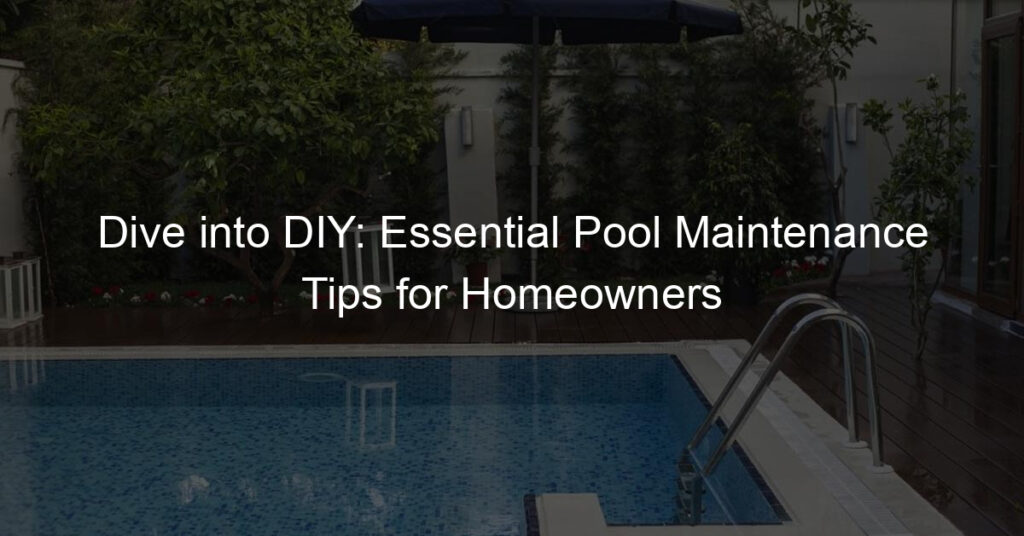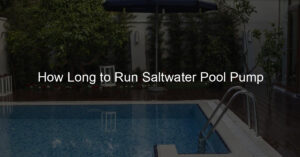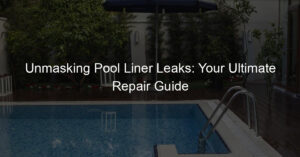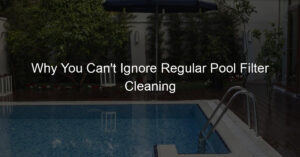Introduction to DIY Pool Cleaning
Having a swimming pool at home is a luxury that comes with its own set of responsibilities. One of the most important tasks is keeping the pool clean and safe for everyone to enjoy. In this guide, we will explore the basics of Do-It-Yourself (DIY) pool cleaning, the importance of regular pool maintenance, and the benefits of taking care of your pool yourself.
- Understanding the Importance of Regular Pool Maintenance
Maintaining your pool regularly is crucial for several reasons. First, it helps keep the water clear and clean, making it inviting for a swim any time you want. Second, it prevents the growth of algae and bacteria, which can cause health issues. Lastly, regular maintenance can save you money in the long run by preventing costly repairs.
- Benefits of DIY Pool Care
Doing your own pool maintenance has its own set of advantages. For one, it can be a cost-effective way of keeping your pool in top shape. You can save on the costs of hiring a professional pool cleaning service. Additionally, it gives you full control over the products and methods used in the cleaning process, allowing you to ensure the safety and health of your family. Lastly, DIY pool care can be a rewarding experience, giving you a sense of accomplishment every time you see your pool sparkling clean.
In the following sections, we will delve deeper into the basics of home pool maintenance, provide a step-by-step guide to DIY pool care, and share some advanced tips for homeowners. We will also discuss the essential tools and supplies for home pool care, and share some real-life case studies of pool cleaning for homeowners. So, let’s dive in and start our DIY swimming pool maintenance journey!
Home Pool Maintenance: The Basics
Understanding the basics of home pool maintenance is the first step towards ensuring your pool stays clean, safe, and enjoyable. Let’s dive in and explore some fundamental aspects of your swimming pool.
Understanding Your Pool
Before you can effectively maintain your pool, it’s crucial to understand the different types of pools and their specific maintenance needs, as well as the key components of a swimming pool.
- Types of pools and their specific maintenance needs
- In-ground pools: These pools are built into the ground and typically require regular cleaning, chemical balancing, and equipment checks.
- Above-ground pools: These pools sit above ground level and often need more frequent cleaning due to their exposure to the elements.
- Saltwater pools: While these pools require less chemical maintenance, they need regular salt level checks and cell cleaning.
- Vinyl liner pools: These pools require careful cleaning to avoid liner damage, and the liner must be replaced every 7-10 years.
- Key components of a swimming pool
There are several types of pools, each with its own unique set of maintenance needs:
Understanding the key components of a swimming pool can help you maintain it effectively. Here are the main parts:
| Component | Description |
|---|---|
| Pool Water | The water in your pool needs to be kept clean and chemically balanced to ensure it’s safe for swimming. |
| Pool Surface | This includes the walls and floor of the pool. They should be kept clean to prevent algae growth and staining. |
| Filter System | The filter system removes debris from the water and should be cleaned regularly to keep it functioning properly. |
| Pool Pump | The pump circulates the water through the filter system and helps distribute chemicals evenly throughout the pool. |
| Skimmer and Returns | The skimmer removes debris from the surface of the water, while the returns push clean water back into the pool. |
By understanding the type of pool you have and its key components, you can tailor your maintenance routine to meet its specific needs. This knowledge is the foundation of effective home pool maintenance.
Essential Pool Care Tips
Keeping your pool sparkling clean doesn’t have to be as cumbersome as you might think. All pools are different, and so are their maintenance needs. However, they all share one commonality: The secret to pristine pool health is regular, routine care. Here are some essential pool care tips that every pool owner should know:
- Regular Skimming and Vacuuming
- Importance of Maintaining Water Levels
- Checking and Adjusting Pool Chemistry
One of the simplest ways to keep your pool clean is by skimming its surface every few days. Skimming significantly increases the pool’s efficiency and lowers the amount of chlorine you need to add to your pool. Vacuuming your pool once a week keeps the water clear and reduces the amount of chemicals you need to add to it. Regular vacuuming also helps to keep the pool’s surface looking clean and inviting.
During the swimming season, you’ll need to monitor the water level. If it falls below the level of the skimmer, the pump could be damaged. If the water level is too high, the skimmer door will not work properly. This is because it floats on the surface of the water, allowing debris to flow back into the pool. Use a garden hose to add water or a submersible pump to remove it.
Maintaining the right chemical balance in your pool is crucial. Test the water at least once a week. Ideally, the pH should be between 7.2 and 7.8. This range is safe for swimmers and helps sanitize the pool effectively. If the pH is too high, the chlorine becomes less effective. Regular testing and adjusting of pool chemistry can prevent skin and eye irritation and the growth of bacteria and algae.
Remember, a clean pool is a safe pool. Regular maintenance not only extends the life of your pool but also makes swimming and relaxing in it a more enjoyable experience. So, roll up your sleeves and get to it. Your pool, and the people who enjoy it, will thank you.
DIY Pool Care: A Step-by-Step Guide
Keeping your pool clean and safe is essential. Here, we will guide you through the weekly maintenance tasks that you can do yourself. These tasks are simple and require only basic tools and supplies.
Weekly Maintenance Tasks
Performing these tasks every week will ensure your pool remains in top shape and ready for use at any time. Let’s dive into these tasks:
-
Testing Water Chemistry
Testing the water chemistry of your pool is crucial to maintaining a healthy and safe swimming environment. You should test your pool’s pH, chlorine, and alkalinity levels. The ideal pH level is between 7.2 and 7.6, while the chlorine level should be between 1.0 and 3.0 parts per million (ppm). Alkalinity should be between 80 and 120 ppm. You can use a pool testing kit to easily check these levels.
-
Cleaning the Pool Surface and Bottom
Keeping the pool surface and bottom clean is essential for maintaining the pool’s aesthetics and hygiene. Use a long-handled net to remove leaves, bugs, and other debris from the surface. For the bottom, use a pool vacuum to clean up any dirt or debris that has settled there. Remember to brush the sides of the pool as well to prevent algae growth.
-
Emptying Skimmer Baskets
Skimmer baskets collect debris from the pool’s surface, helping to keep the water clean. However, if they become too full, they can’t do their job effectively. Make sure to check and empty your skimmer baskets every week. Simply remove the basket, empty the contents, rinse it out, and replace it.
By following these weekly maintenance tasks, you can ensure your pool remains clean, safe, and ready for use. Remember, regular maintenance is key to extending the life of your pool and ensuring it’s always ready for a refreshing dip.
Monthly Maintenance Tasks
While weekly tasks are essential for maintaining the cleanliness and safety of your pool, monthly tasks ensure the longevity of your pool equipment and the overall health of your pool. Let’s delve into these tasks:
-
Checking pool equipment for wear and tear
Pool equipment such as pumps, heaters, and automatic cleaners are the backbone of your pool’s operation. Over time, they may show signs of wear and tear that could lead to more significant problems if not addressed. Every month, take the time to inspect your equipment. Look for signs of damage like cracks, leaks, or unusual noises. If you notice anything out of the ordinary, it might be time to repair or replace the affected part.
-
Cleaning the pool filter
Your pool filter plays a crucial role in keeping your pool water clear and free of debris. Over time, the filter can become clogged, reducing its efficiency. To maintain optimal performance, it’s important to clean your pool filter monthly. This involves removing the filter, rinsing it thoroughly, and letting it dry before reinstalling it. Remember, a clean filter means a clean pool!
-
Inspecting pool safety features
Pool safety is paramount. Every month, take the time to inspect your pool’s safety features. This includes checking the integrity of fences or barriers, ensuring gate latches are working correctly, and verifying that pool alarms are functioning. Remember, these safety features are there to protect you, your family, and any visitors to your pool. Regular inspections ensure they can do their job effectively.
By incorporating these monthly tasks into your pool maintenance routine, you’ll help ensure your pool stays in top shape for years to come. Remember, a well-maintained pool is a safe and enjoyable pool!
Homeowners Pool Maintenance Guide: Advanced Tips
As a homeowner, maintaining your swimming pool can seem like a daunting task. However, with the right knowledge and tools, you can ensure your pool stays clean, safe, and ready for use. Let’s dive into some advanced tips for maintaining your pool during the off-season.
Maintaining Home Swimming Pool During Off-Season
During the off-season, your pool requires special attention to ensure it remains in good condition. This involves two key steps: winterizing your pool and preparing it for the summer.
- Winterizing Your Pool
- Preparing Your Pool for Summer
Winterizing your pool is crucial to prevent damage from freezing temperatures. Start by balancing the water chemistry. This helps prevent scale build-up and corrosion. The ideal pH level should be between 7.2 and 7.6. Next, clean your pool thoroughly. Remove any leaves, dirt, and debris. Finally, lower the water level to below the skimmer and cover the pool to protect it from harsh weather conditions.
As the weather begins to warm up, it’s time to prepare your pool for summer. Remove the pool cover and clean it thoroughly. Raise the water level back to normal and reconnect all the pool equipment. Test the water chemistry and adjust as necessary. Lastly, run the pool filter system for at least 12 hours to ensure the water is clean and clear.
Remember, maintaining your pool during the off-season will make it easier to open when summer arrives. It also extends the life of your pool and saves you money in the long run. So, don’t neglect your pool during the colder months!
Dealing with Common Pool Problems
As a pool owner, you may encounter a few common problems that can affect the cleanliness and safety of your pool. These issues include algae growth, cloudy water, and equipment failure. Let’s delve into each of these problems and learn how to handle them effectively.
- Algae Growth
- Cloudy Water
- Equipment Failure
Algae are small plants that can grow in your pool, turning the water green and making the pool surfaces slippery. They thrive in warm, sunny conditions and can multiply rapidly if not treated promptly. To combat algae growth, ensure your pool’s pH level is balanced, regularly brush and vacuum your pool, and use an algaecide if necessary. Remember, prevention is always better than cure.
Cloudy or murky pool water can be caused by various factors, including improper chemical balance, poor filtration, or the presence of contaminants. Regularly test your pool water and adjust the chemicals as needed. Also, ensure your pool filter is clean and functioning correctly. If the water remains cloudy despite these measures, consider using a pool clarifier to bind the tiny particles causing the cloudiness, making them easier to filter out.
Pool equipment, like pumps and filters, can sometimes fail or malfunction, leading to various pool problems. Regular maintenance is key to preventing equipment failure. Keep an eye on your pool equipment, clean it regularly, and promptly repair or replace any parts that appear worn or damaged. If you’re unsure about handling pool equipment, don’t hesitate to seek professional help.
In conclusion, dealing with common pool problems can be straightforward if you understand what causes them and how to address them. Regular pool maintenance and prompt attention to any issues that arise will keep your pool clean, safe, and enjoyable for everyone.
DIY Pool Maintenance Tips: Safety First
When it comes to maintaining your pool, safety should always be your top priority. It’s not just about keeping the water clean and clear; it’s also about ensuring that the pool environment is safe for everyone. Let’s explore some essential safety tips for DIY pool maintenance.
- Proper handling and storage of pool chemicals
- Ensuring pool safety features are in place and functional
Pool chemicals, such as chlorine and muriatic acid, are necessary for keeping your pool clean and safe. However, these chemicals can be hazardous if not handled or stored correctly. Always wear protective gear, like gloves and goggles, when handling these chemicals. Keep them in a cool, dry place, out of reach of children and pets. Never mix different chemicals, as this can cause dangerous reactions.
Pool safety features, like fences, gates, and pool covers, are crucial in preventing accidents. Regularly check these features to ensure they are in good working condition. Fences and gates should be sturdy and secure, with no gaps or broken parts. Pool covers should be strong enough to hold a person’s weight without collapsing. Also, consider installing a pool alarm that can alert you if someone falls into the pool.
Remember, safety is not something to be compromised. By following these tips, you can ensure a safe and enjoyable pool environment for everyone. Happy swimming!
Home Pool Care Essentials: Tools and Supplies
Keeping your home pool clean and well-maintained is a task that requires the right tools and supplies. In this section, we will discuss the essential pool cleaning tools and recommended pool maintenance supplies that every homeowner should have.
- Essential Pool Cleaning Tools
These are the must-have tools for every homeowner who wants to keep their pool clean and inviting:
- Pool Skimmer: This is a net attached to a long pole, used for removing leaves and other debris from the surface of the pool.
- Pool Brush: A sturdy brush is necessary for scrubbing the pool walls and floor to prevent algae growth.
- Pool Vacuum: This tool is used for cleaning the bottom of the pool, removing dirt and small debris that the skimmer can’t reach.
- Telescopic Pole: This extendable pole can be used with different attachments like the skimmer and brush, making it easier to reach all areas of the pool.
- Recommended Pool Maintenance Supplies
Along with the cleaning tools, there are several supplies that you will need for maintaining the quality of your pool water:
- Pool Chemicals: These include chlorine or bromine for sanitizing the water, algaecide for preventing algae growth, and pH balancers to maintain the right water chemistry.
- Water Testing Kit: This kit is used to test the water for its pH level, chlorine level, and other chemical balances. Regular testing ensures that your pool water is safe for swimming.
- Pool Filter: A good quality filter is essential for keeping your pool water clear and free from impurities.
- Pool Cover: A cover is necessary for protecting your pool from debris when it’s not in use. It also helps in reducing water evaporation.
Remember, regular pool maintenance not only keeps your pool clean and safe for swimming but also extends its lifespan. So, invest in these essential tools and supplies and enjoy your DIY pool maintenance journey.
Pool Cleaning for Homeowners: Case Studies
Real-life examples can be a great source of learning. Let’s take a look at some case studies that demonstrate the impact of regular pool maintenance and the transformation that can occur with a little effort and the right tools.
Case Study 1: Transforming a Neglected Pool
Our first case study involves a homeowner named John. John had inherited a home with a large, neglected swimming pool. The pool was filled with murky water, algae growth, and debris. It looked like a daunting task, but John was determined to restore the pool to its former glory.
John started by investing in the essential pool cleaning tools and supplies. He purchased a pool skimmer, vacuum, brush, and the necessary chemicals to balance the water. He also invested in a water testing kit to ensure the pool’s pH and chlorine levels were correct.
John began the transformation process by skimming the pool daily to remove debris. He then brushed the pool walls and floor to dislodge algae and other build-ups. The pool vacuum was used to remove the dislodged debris from the pool floor.
Next, John focused on balancing the pool water. He used his water testing kit to check the pH and chlorine levels. Based on the results, he added the necessary chemicals to balance the water. This step was crucial in preventing future algae growth and ensuring the water was safe for swimming.
After several weeks of consistent effort, John’s pool was transformed. The water was crystal clear, and the pool looked inviting. John’s case demonstrates that with the right tools, supplies, and a little determination, even the most neglected pool can be transformed into a beautiful oasis.
| Steps Taken | Tools Used | Results |
|---|---|---|
| Skimming the pool daily | Pool skimmer | Removal of debris |
| Brushing the pool walls and floor | Pool brush | Dislodging of algae and build-up |
| Vacuuming the pool | Pool vacuum | Removal of dislodged debris |
| Testing and balancing the water | Water testing kit and pool chemicals | Safe, balanced water |
John’s story is a testament to the power of regular pool maintenance. It shows that with the right tools and a bit of effort, anyone can transform a neglected pool into a beautiful and safe place to swim.
Case Study 2: Maintaining a Crystal Clear Pool Year-Round
Let’s dive into our second case study, which focuses on the year-round maintenance of a crystal clear pool. This case study will provide you with a real-life example of how consistent care and attention can result in a sparkling, clean pool all year round.
Meet John, a homeowner who lives in a region with a mild climate, allowing him to use his pool throughout the year. John’s primary goal was to keep his pool crystal clear and ready for use at any time. Here’s how he achieved it:
Regular Cleaning
John made sure to clean his pool regularly. He skimmed the surface of the pool daily to remove leaves and other debris. He also vacuumed the pool and brushed the walls and floor weekly to prevent algae build-up.
Consistent Chemical Balance
John understood the importance of maintaining a balanced chemical level in his pool. He tested the water weekly and adjusted the chemicals as needed. This not only kept the water clear but also prevented damage to the pool equipment.
Proper Pool Equipment Maintenance
John regularly checked and maintained his pool equipment. He cleaned the pool filter monthly and serviced the pool pump annually to ensure they were working efficiently.
Professional Help
Even though John was a DIY enthusiast, he understood the importance of professional help. He had a professional pool service come in for an annual check-up to ensure everything was in order.
| Activity | Frequency |
|---|---|
| Surface Skimming | Daily |
| Vacuuming and Brushing | Weekly |
| Chemical Testing | Weekly |
| Filter Cleaning | Monthly |
| Pump Servicing | Annually |
| Professional Check-up | Annually |
By following this routine, John was able to maintain a crystal clear pool year-round. This case study shows that with regular care and attention, you too can enjoy a clean, sparkling pool all year round.
Conclusion: Enjoying Your DIY Swimming Pool Maintenance Journey
As we wrap up this comprehensive guide on DIY swimming pool maintenance, it’s important to remember that the journey to a clean, safe, and enjoyable pool is one of continuous learning and improvement. Let’s take a moment to recap some of the essential tips we’ve covered and encourage you to keep exploring and enhancing your pool care skills.
- Recap of essential pool maintenance tips
- Encouragement for continued learning and improvement
Throughout this guide, we’ve discussed a variety of tips and tricks to help you maintain your pool. We started with the basics, such as understanding the importance of regular cleaning and the role of chemicals in keeping your pool safe. We then moved on to more advanced topics, like how to handle specific pool problems and the essential tools and supplies you’ll need. We also emphasized the importance of safety first in all your pool maintenance activities. Remember, consistency is key in pool maintenance. Regular checks and cleaning can prevent many common pool problems.
While this guide provides a solid foundation for DIY pool maintenance, there’s always more to learn. The world of pool care is vast and constantly evolving, with new products, techniques, and technologies emerging all the time. Don’t be afraid to continue your research, ask questions, and seek advice from experts. Every bit of knowledge you gain makes you better equipped to keep your pool in top condition.
In conclusion, maintaining your own swimming pool can be a rewarding and enjoyable journey. It not only saves you money but also gives you a sense of accomplishment and the peace of mind that comes from knowing your pool is well cared for. So, dive in and enjoy the process!














